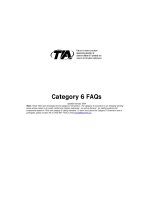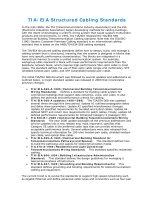Tài liệu Cabling Standard - TIA - Category 6 - Static discharge bewteen LAN cabling & data terminal equipm doc
Bạn đang xem bản rút gọn của tài liệu. Xem và tải ngay bản đầy đủ của tài liệu tại đây (334.14 KB, 9 trang )
Category 6 Cabling:
Static Discharge Between LAN Cabling and Data
Terminal Equipment
Published by the Category 6 Consortium
Telecommunications Industry Association
December 2002
OOvveerrvviieeww
The following white paper was produced by participants of the Category 6 Consortium. This con-
sortium — focused on category 6 cabling systems — has assisted in development of generic stan-
dards primarily for balanced twisted-pair cabling systems. These standards cover balanced twist-
ed-pair cable and associated connecting hardware specifications, including test procedures, per-
formance requirements and test instrument requirements. In development of these standards, the-
oretical models and controlled experimentation were used to validate link and channel specifica-
tions via component requirements.
On June 20, 2002 TIA published the category 6 addition to the TIA-568 standard, which has the
official document number of ANSI/TIA/EIA-568-B.2-1. Following its passage, the Category 6
Consortium has been formed to promote the adoption of category 6. As part of the mission to
provide user education, the Category 6 Consortium is releasing this document to give industry
participants additional information on electrostatic discharge (ESD) - what it is, how it affects
telecommunications cabling and equipment, and what is being done to protect equipment from
damage due to ESD. It is important to note that any opinions expressed in this white paper are
those of the participants of the Category 6 Consortium and are not necessarily those of the entire
TIA membership.
For more information about category 6, please visit the Category 6 Consortium Web site at
www
.category6.org or contact TIA at (703) 907-7472.
Category 6 Cabling: Static Discharge Between LAN Cabling and Equipment 1
WWhhaatt iiss EElleeccttrroossttaattiicc DDiisscchhaarrggee??
Electrostatic charges are generated when different materials come into contact and are then sep-
arated. When materials come into contact, a chemical bond of varying strength is formed
between the two materials. The chemical bond involves a migration of electrons from one materi-
al to the other. When this bond is broken, some of the electrons may be left behind and result in
an excess negative or excess positive charge on the materials. This charging effect caused by con-
tact is made even greater by friction such as rubbing the two materials together. This phenome-
non is called "triboelectric effect," or "triboelectric charging."
The amount of charge that is generated can be significant, in many cases tens of thousands of
volts. The amount of charge, and hence the voltage that can be supported by a material, is gov-
erned by its bulk resistance or insulation properties. A capacitor is a device designed to store
charge that has a good insulator sandwiched between two good conductors. The charge is stored
in the insulator. A good conducting path will allow this stored charge to dissipate rapidly. This is
called electrostatic discharge, or ESD. "Rapidly" is the key word because this quick discharge of
large amounts of potential energy can cause damage. A slow or controlled discharge is one of the
more useful ESD protection strategies.
HHooww DDooeess EESSDD AAffffeecctt TTeelleeccoommmmuunniiccaattiioonnss CCaabblliinngg aanndd EEqquuiippmmeenntt??
Any users (installers, administrators, end users, etc.) that touch equipment or cabling become a
potential source of ESD into communications equipment. For example, a person can become
charged by triboelectric effect by walking across a carpeted floor. The international standard
IEC/EN 61000-4-2 specifies test levels and procedures for manufacturers to verify equipment
immunity to discharge from a human body. It also includes guidelines for the manufacturer to
specify for the installation and handling of equipment.
Another subtler source of ESD is from charged cabling. The IEEE 802.3 standards identify this
problem, but do not provide any guidance or testing methods for manufacturers. Generally, users
become a source of ESD to the cabling (which is of course totally immune to ESD), and the
charged cabling then becomes a source of ESD to the communications equipment. Cables can
acquire a charge during installation when they are unreeled from a cable reel, or dragged across a
floor. There also have been reports of cables developing their own charge from moving air or from
building occupants walking over floor ducts. If the cables are not connected to earth ground, the
electrostatic charges can remain for a long time, especially in dry conditions.
WWhhaatt PPrreeccaauuttiioonnss AArree NNeecceessssaarryy ttoo AAvvooiidd EEqquuiippmmeenntt DDaammaaggee??
The IEEE has warned about the effects of ESD on equipment by incorporating guidelines in 802.3i-
1990 Twisted-Pair MAU and Baseband Medium, Type 10BASE-T since 1990. The same guidelines
continue to be incorporated in subsequent applications, including 802.3u-1995 Type 100BASE-T,
802.3x-1997, 802.3y-1997 (100BASE-T2), 802.3ab-1999, Type 1000BASE-T. The following is a
direct quote from section 14.7.2 of the 10BASE-T document:
““1144..77..22 NNeettwwoorrkk SSaaffeettyy::
(2) Static charge buildup on LAN cables and components. Such electrical safety haz-
ards must be avoided or appropriately protected against for proper network installa-
Category 6 Cabling: Static Discharge Between LAN Cabling and Equipment 2
tion and performance. In addition to provisions for proper handling of these condi-
tions in an operational system, special measures must be taken to ensure that the
intended safety features are not negated during installation of a new network or
during modification or maintenance of an existing network."
Although these guidelines are written for the manufacturer, the intent is that they be incorporat-
ed into the manufacturer's product documentation as well. With properly designed equipment and
good installation practices, the numbers of ESD problems that have been reported over the last
ten years have been very limited.
AArree CCaatteeggoorryy 66 CCaabblleess WWoorrssee TThhaann CCaatteeggoorryy 55 CCaabblleess ffoorr EESSDD EEffffeeccttss??
A cable's capacitance to ground determines how much charge a cable will hold. Once a cable is
charged, its capacitance to ground and the relative humidity typically determine how fast the
charge will dissipate. Generally, dielectric materials and the capacitances associated with category
5e and category 6 cable designs are the same as those associated with category 5 cables. Hence,
the ESD discharge properties of these cables are not significantly different. This was confirmed by
laboratory measurements of discharge patterns as outlined in the following experiment.
A Human Body Model ESD generator, of the kind described in IEC 61000-4-2, was used to inject
an 8KV contact-discharge pulse into one end of a conductor pair of an assortment of category 5
and category 6 UTP cables, each about 56 meters in length. After charging, a cable discharge
waveform was then measured into a high-speed waveform recorder. These discharges were
recorded as a function of the time interval between the charging and the discharging of the con-
ductor pair so that a charge retention profile was also recorded for each cable. To ensure repeata-
bility and a fair comparison, each cable was laid directly on a ground plane for its entire length.
This also maximizes its capacitance to ground. (See Figures 1, 2 and 3).
Figure 1: Charging Point
Category 6 Cabling: Static Discharge Between LAN Cabling and Equipment 3
Figure 2: Cable Layout
Category 6 Cabling: Static Discharge Between LAN Cabling and Equipment 4
Figure 3: Discharging Point









